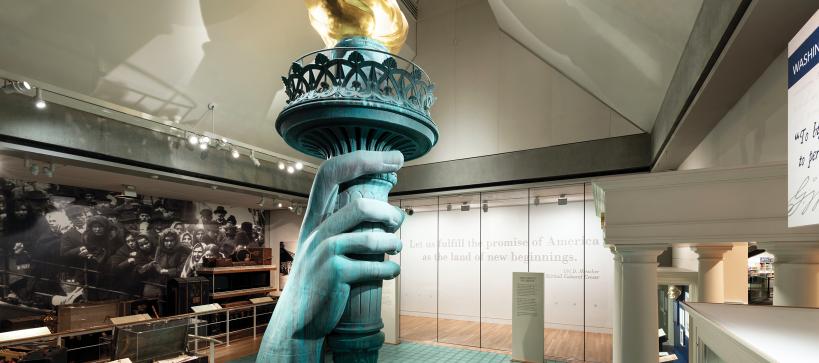
Visions and Values
Jewish Life from Antiquity to America
Ongoing

Jewish Life from Antiquity to America
Ongoing
Engage with four thousand years of Jewish history and discover how ancestral visions shape modern values.
$18 General
$13 Seniors, Full-Time Students with ID, and Children 2–17
FREE to Members and Children under 2
FREE to all on Thursdays
Please note: Admission prices increase $2.00 effective January 1, 2026. General Admission tickets provide visitors access to all exhibitions on view at the Skirball, as well as our new Bloom Garden and other family-friendly activities. Visitors who would like to board Noah’s Ark, which requires timed entry, should purchase a separate Noah's Ark ticket (which also includes general admission access).
Featuring changing displays of works from the Skirball’s permanent collection of Judaica—one of the largest in the world—this historically illuminating exhibition chronicles the struggles and achievements of the Jewish people over a span of four thousand years.
Travel through the many lands and civilizations where Jews have lived and discover how ancestral visions continue to shape modern values. The Visions and Values galleries—Beginnings, Journeys, Holidays, Lifecycle, Synagogue, Passage to America, Nation of Immigrants, Struggle and Opportunity, the Holocaust, the State of Israel, and At Home in America—take the visitor on an unforgettable voyage of learning and discovery.
“I am always awed by the Visions and Values exhibition.”
Join a docent-led public tour of this exhibition's Hanukkah artifacts.
December 4–28
Thursdays, Saturdays, and Sundays, 12:30 and 2:00 pm
Note: Public Tours are subject to cancellation.
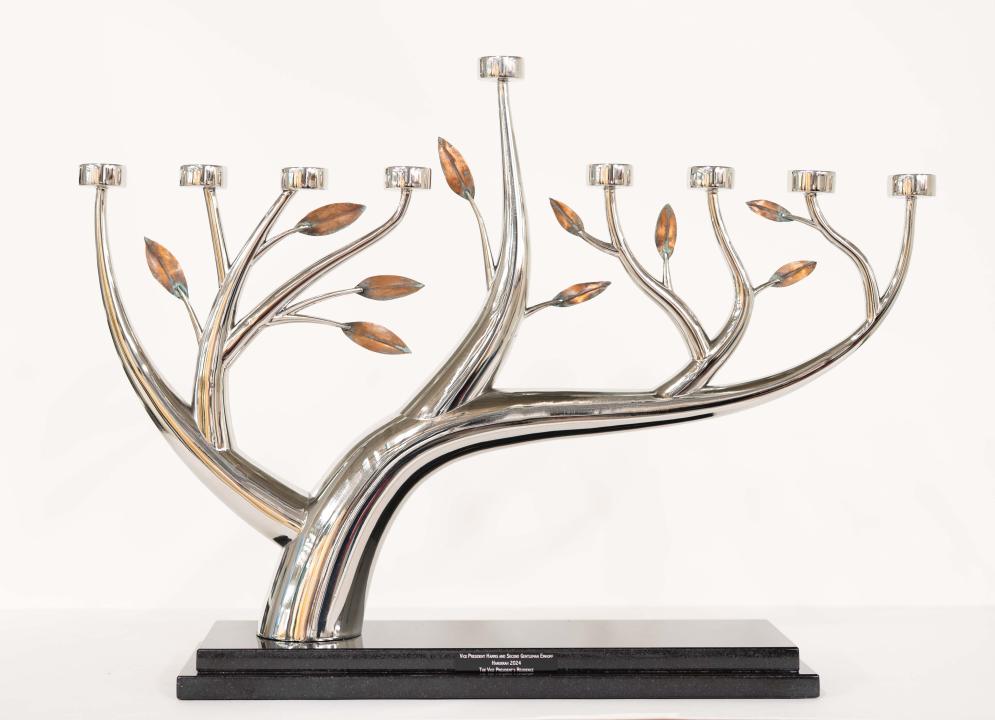
Zachary Oxman (b. 1968). In Celebration of Light and Liberty, 2024. Stainless steel, copper, and granite. Vice President’s Residence Foundation.
While you’re here, come see a special Hanukkah lamp designed by Jewish American artist Zachary Oxman for the official residence of the Vice President of the United States. First displayed when former U.S. Vice President Kamala Harris and Doug Emhoff—the first Jewish Second Gentleman—lived in the residence, this menorah blends Jewish tradition with American history. Oxman shaped the lamp like a pomegranate tree, a symbol with deep meaning in Judaism. The arms evoke tree branches, with leaves made from copper salvaged from the old roof of the Grand Salon at Ellis Island—the first point of entry to the United States for millions of immigrants, including many Jews from Central and Eastern Europe.
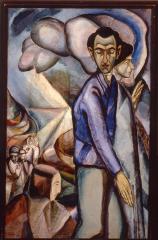
Gift of Peter and Rose Krasnow. SCC 41.289
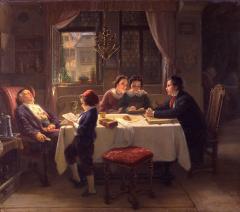
Oil on canvas
Jewish Cultural Reconstruction, Inc. SCC 41.135
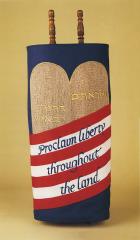
Wool, embroidered and appliqued with cotton and metallic thread
Skirball Museum Commission. SCC 60.138
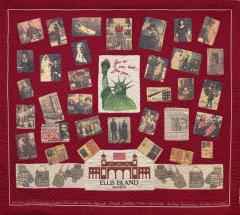
The quilt pictured above was created by the Hamish Amish Quilters of Van Nuys, California. This community of Jewish quilters incorporated photographic images of family members and historical events, depicting the story of nineteenth-century Central and Eastern European Jewish immigrants. Thirty individual patches surround an image of the Statue of Liberty and American Jewish poet Emma Lazarus’s famous words, “Give me your tired . . . / Your poor . . . .” A personal tribute to a shared experience.
Hamish Amish Quilters, Ellis Island Quilt, Van Nuys, CA. Textile. Gift of the Hamish Amish Quilters and their families. Skirball Cultural Center, Los Angeles. 25.238.
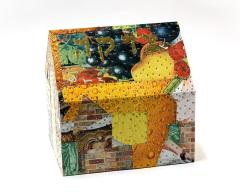
When the artist Tony Berlant created this tzedakah box, he wanted to highlight the value of Jewish charity—anonymously helping those in need. By overlaying the brick structure with imagery of a bountiful harvest, Berlant conveys the basic human needs for food and shelter.
Tony Berlant, Tzedakah Box, Los Angeles, California, 1994. Found tin collage over plywood with steel brads. Skirball Museum commission with funds provided by the Museum Membership. SCC 1.33
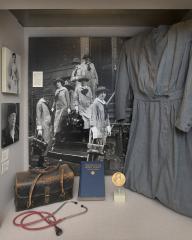
Highlighting the work of Lillian Wald (1867–1940), a New York social worker/nurse, this display within Visions and Values emphasizes the importance of social welfare in American Jewish values.
Display on social Reformer Lillian Wald. Photo by Robert Wedemeyer.
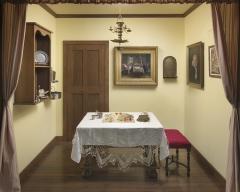
Based on the painting Sabbath Afternoon by Moritz Oppenheim (pictured next), this display within Visions and Values brings to life Oppenheim’s interpretation of a comfortable Jewish home, evoking the peace of the Sabbath.
Shabbat (Sabbath) tableau inspired by the Moritz Oppenheim painting Sabbath Afternoon, Frankfurt am Main, Germany, c. 1866, Oil on canvas, Jewish Cultural Reconstruction, Inc. SCC 41.135. Photo by Robert Wedemeyer.
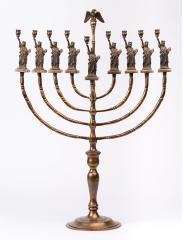
Museum purchase with Project Americana funds provided by Peachy and Mark Levy. HUCSM 27.154. Photo by Susan Einstein.
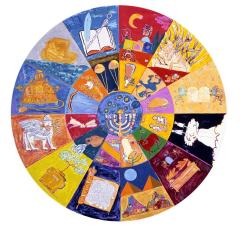
Contemporary artist Mark Podwal has created modern interpretations of rabbinic writings and Jewish lore in his colorful, energetic works, such as Zodiac Circle. A menorah occupies the central position of the sun, around which the planets revolve. The signs of the zodiac are aligned with the twelve Hebrew months arranged in concentric circles. The sequence of Jewish holidays is arranged counterclockwise from the New Year, and each holiday is represented with imagery ranging from the profound to the whimsical.
Mark Podwal, Zodiac Circle, 1995. Gouache, ink, and colored pencil on paper, 48 x 48 in. (121.9 x 121.9 cm.) Museum commission with funds provided in honor of Marian and Don DeWitt by their children and their families. Skirball Cultural Center, Los Angeles. 10.12a.
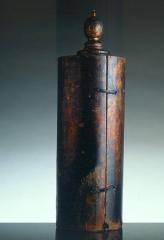
Wood, lacquered, and gilt, bronze, and iron
Skirball Museum. SCC 57.2
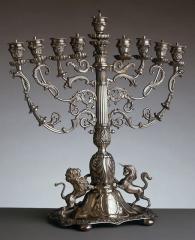
Silver, cast and chased
Jewish Cultural Reconstruction, Inc. SCC 27.98
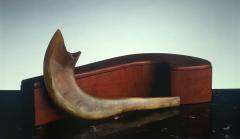
Wood, ram's horn
Gift of the Family of Marcus Jonas of Oakland, California. SCC 52.36
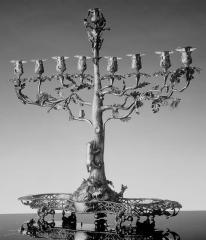
Silver, repoussé, cast and parcel-gilt
Skirball Museum. SCC 27.100
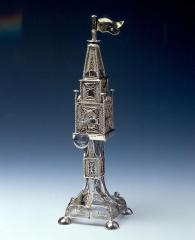
Silver, filigree
Jewish Cultural Reconstruction, Inc. SCC 53.77
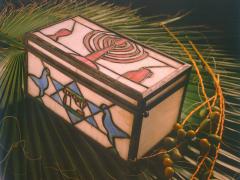
Leaded glass
Gift of Mr. and Mrs. Joseph Hirsch. SCC 14.108
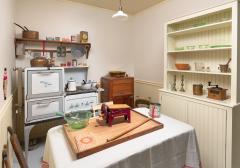
Between 1880 and 1924, more than two million Jews immigrated from Eastern Europe to the United States in search of a better life. On view in Visions and Values, this tableau depicts a typical, new Jewish immigrant’s kitchen from that period. Look closely to find objects from the “Old Country” mixed in with newer “Americanized” methods of food preparation.
Early twentieth-century American Jewish immigrant kitchen tableau. Photo by Robert Wedemeyer.
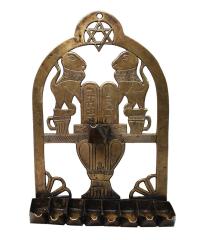
The light from this oil-burning Hanukkah lamp in the Skirball's permanent collection once illuminated a Moroccan Jewish home during the eight nights of Hanukkah. Until the late 1940s, Morocco was home to over a quarter of a million Jews. Today, most Moroccan Jews and their descendants live in Israel, France, and Canada, as well as in the United States, where they keep their vibrant holiday traditions alive.
Hanukkah Lamp, Morocco, twentieth century. 13 3/4 x 9 3/8 x 3 1/2 in. Maurice Amado Foundation. Skirball Cultural Center, Los Angeles. 27.194.
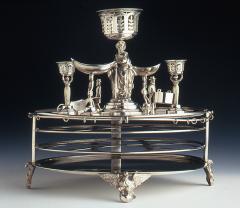
This intricate and playful Seder plate on display in Visions and Values features figurines that carry cups for the six symbolic foods that tell the story of Passover. At the center, you can see the main character, Moses, holding up the cup of Elijah. In an act of welcome, Jews traditionally leave a cup of wine for the prophet Elijah and open the door for him to join symbolically at the conclusion of the meal.
Franz Strobl (assumed), Tiered Seder Plate, Vienna, Austria, 1814. SCC 50.12. Photo by John Reed Forsman.